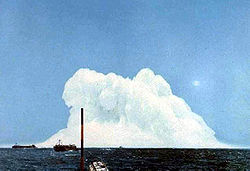
Mark 90 Betty nuclear bomb
Encyclopedia

Cold War
The Cold War was the continuing state from roughly 1946 to 1991 of political conflict, military tension, proxy wars, and economic competition between the Communist World—primarily the Soviet Union and its satellite states and allies—and the powers of the Western world, primarily the United States...
nuclear
Nuclear weapon
A nuclear weapon is an explosive device that derives its destructive force from nuclear reactions, either fission or a combination of fission and fusion. Both reactions release vast quantities of energy from relatively small amounts of matter. The first fission bomb test released the same amount...
depth charge
Depth charge
A depth charge is an anti-submarine warfare weapon intended to destroy or cripple a target submarine by the shock of exploding near it. Most use explosives and a fuze set to go off at a preselected depth in the ocean. Depth charges can be dropped by either surface ships, patrol aircraft, or from...
, developed by the United States
United States
The United States of America is a federal constitutional republic comprising fifty states and a federal district...
in 1952.
It had a length of 10 ft 2 in, a diameter of 2 ft 7.5 in, and a weight of 1,243 lb, and it carried a Mark 7
Mark 7 nuclear bomb
Mark 7 "Thor" was the first tactical nuclear bomb adopted by US armed forces. It was also the first weapon to be delivered using the toss method with the help of the low-altitude bombing system . The weapon was tested in Operation Buster-Jangle. To facilitate external carry by fighter bomber...
nuclear warhead with a yield of 5-10 kilotons. Its purpose was to serve as an anti-submarine weapon
Anti-submarine weapon
An anti-submarine weapon is any one of a range of devices that are intended to act against a submarine, and its crew, to destroy the vessel or to destroy or reduce its capability as a weapon of war...
for the United States Navy
United States Navy
The United States Navy is the naval warfare service branch of the United States Armed Forces and one of the seven uniformed services of the United States. The U.S. Navy is the largest in the world; its battle fleet tonnage is greater than that of the next 13 largest navies combined. The U.S...
.
A test of the Mark 90 was conducted in 1955, as Operation Wigwam
Operation Wigwam
Operation Wigwam involved a single test of the Mark 90 Betty nuclear bomb. It was conducted between Operation Teapot and Operation Redwing on May 14, 1955, about 500 miles southwest of San Diego, California. 6,800 personnel aboard 30 ships were involved in Wigwam...
.
All units were withdrawn from service by 1960.
Accident
On September 25, 1959, a United States Navy Martin P5M-2 Marlin (BuNo 135540, SG tailcode, '6', of VP-50) was patrolling out of NAS Whidbey Island, Washington on Puget SoundPuget Sound
Puget Sound is a sound in the U.S. state of Washington. It is a complex estuarine system of interconnected marine waterways and basins, with one major and one minor connection to the Strait of Juan de Fuca and the Pacific Ocean — Admiralty Inlet being the major connection and...
, when it was forced to ditch in the Pacific Ocean
Pacific Ocean
The Pacific Ocean is the largest of the Earth's oceanic divisions. It extends from the Arctic in the north to the Southern Ocean in the south, bounded by Asia and Australia in the west, and the Americas in the east.At 165.2 million square kilometres in area, this largest division of the World...
, about 100 miles west of the Washington-Oregon
Oregon
Oregon is a state in the Pacific Northwest region of the United States. It is located on the Pacific coast, with Washington to the north, California to the south, Nevada on the southeast and Idaho to the east. The Columbia and Snake rivers delineate much of Oregon's northern and eastern...
border.
A Mark 90 depth charge casing was lost and never recovered, but it was not fitted with an active warhead
Warhead
The term warhead refers to the explosive material and detonator that is delivered by a missile, rocket, or torpedo.- Etymology :During the early development of naval torpedoes, they could be equipped with an inert payload that was intended for use during training, test firing and exercises. This...
. The ten crew were rescued by the US Coast Guard, after ten hours in a raft. The press was not notified at the time.

